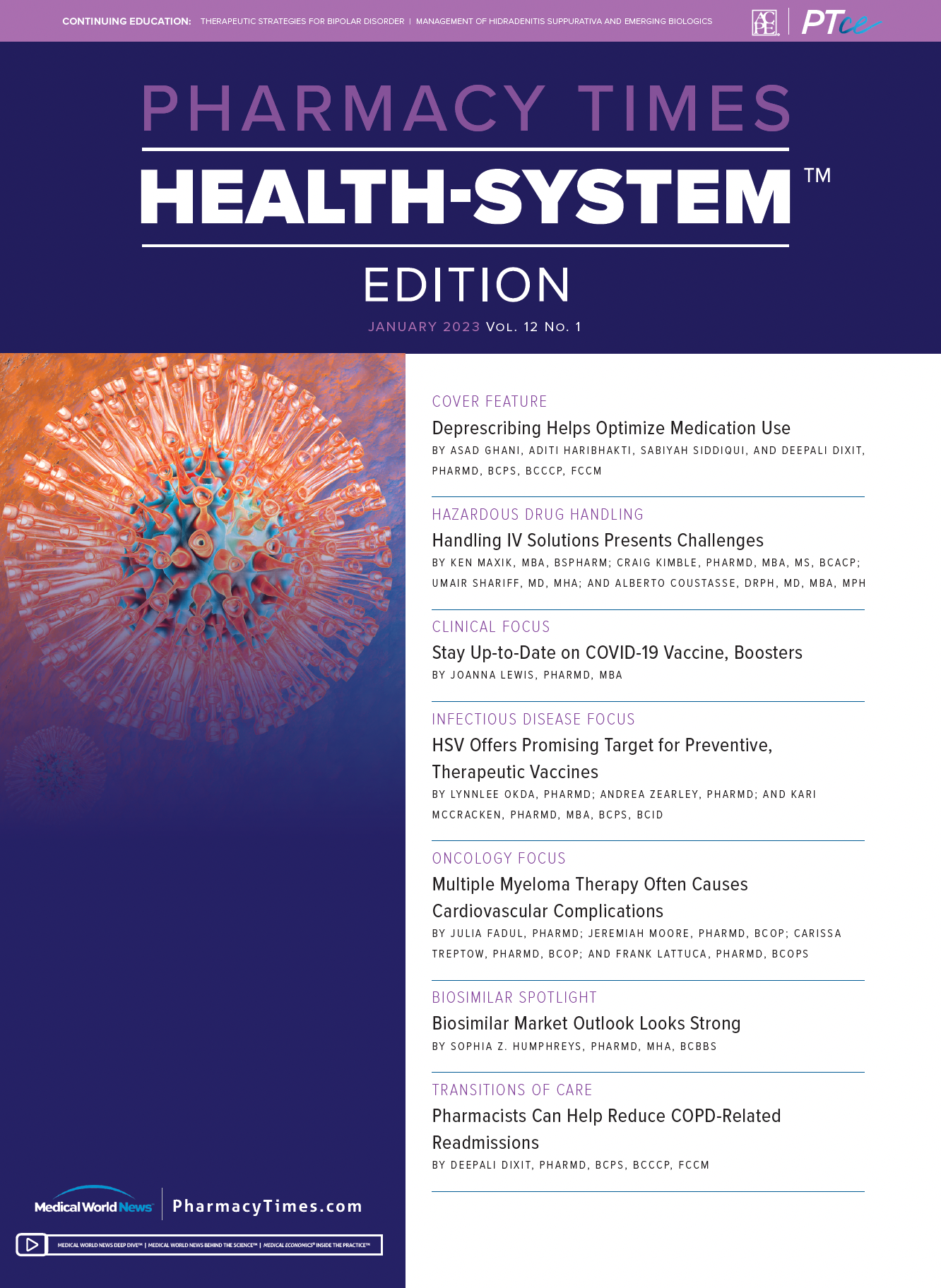
Publication
Article
Pharmacy Practice in Focus: Health Systems
Pharmacists Can Help Reduce COPD-Related Readmissions
Author(s):
Variety of interventions improves morbidity, mortality, associated costs for patients with chronic obstructive pulmonary disorder.
Chronic obstructive pulmonary disease (COPD) is a chronic, progressive lung disease that is characterized by respiratory symptoms associated with chronic airflow limitation, affecting an estimated 300 million individuals globally.1,2 COPD is now the third leading cause of death worldwide, with approximately 3 million individuals dying annually from the disease.1,2
The risk of mortality from COPD increases significantly in the first year after readmission within 30 days of hospitalization.3 Among patients readmitted within that time span, the projected absolute increase in mortality risk is 4% at 30 days.3 Meanwhile, for patients with severe disease, the 2-year mortality rate is estimated to be 50%.3 Because of this, COPD represents an essential health challenge that is preventable and treatable.
Historically, the United States health care system was sustained by prospective payment, minimizing hospital length of stay and maximizing turnover.4 In an effort to improve the quality of care and reduce readmission risks, the Centers for Medicare & Medicaid Services (CMS) Hospital Readmissions Reduction Program was launched in 2012.5 Hospitals were fined up to 1% of diagnosis-related group payments (this penalty increased to 3% in 2015) for too many readmissions, totaling almost $1.9 billion in penalties.6
On average, a COPD-related emergency department visit costs $647, whereas an admission ranges from $7242 (nonintensive care unit) to $44,909 (intensive care unit with intubation).7 These costs increase over the years and can be intensified by continuous readmissions. Approximately 20% of patients hospitalized for COPD exacerbation are readmitted within 30 days of discharge.3 Additionally, a history of 2 or more exacerbations in the previous year predicts the 30-day readmission of patients with COPD, suggesting that there are numerous opportunities to prevent readmissions and their associated consequences.3
The risk factors for rehospitalization in patients with COPD vary depending on the patient’s condition, providers, and system factors. These can include older age at diagnosis, COPD severity, current smoking habit, intervention before admission, low body mass index, and comorbidities.1,2 Among these factors, 2 amendable risk factors of early readmission for patients with COPD are health care providers and system factors. When the readmission rate is high and unexplained, it may be a result of issues in the transition process and postdischarge management. This makes it imperative that health care providers in acute care settings carefully review the discharge process to diminish readmission risks. Appropriately managed and effective care transitions for patients with COPD can prevent the risk of readmission and mortality, especially for those who need a wide range of services (Table8).

Pharmacists are well positioned to be involved in reducing readmissions with a wide variety of interventions, such as counseling prior to hospital discharge, medication reconciliation, therapy change management, dispensing, postdischarge phone calls, and face-to-face and/or telemedicine visits. The National Transitions of Care Coalition supports pharmacist inclusion to help reduce readmissions.9 Recent studies have demonstrated that pharmacists’ involvement, specifically in COPD care, leads to improved discharge medication reconciliation for the elderly (n = 29) and reduced 30-day readmissions from 22.2% to 16.0%.10 Likewise, another study showed that pharmacists dispensing inhalers and conducting discharge counseling (n = 620) reduced 30- and 60-day readmissions from 21.4% to 8.7% (P = .0016) and 33% to 23% (P = .0056), respectively.11
Additionally, in a more recent retrospective study, investigators sought to evaluate the impact of a comprehensive and collaborative pharmacist transitions of care service for hospitalized patients with COPD compared with usual care.12 The pharmacist interventions included discharge counseling, medication reconciliation, medication access assistance, therapy changes, and postdischarge long-term follow-up provided to underserved patients with a primary care provider at the study clinic and admitted to the affiliated hospital with a primary diagnosis of COPD exacerbation. The primary outcome was a 180-day composite of COPD related hospitalizations and emergency department visits. The study results identified 65 patients, with a total of 101 index admissions. The mean age of the cohort was 62.5 years, approximately 55.3% were women, and 67.7% were Black or African American.12
The primary composite was significantly lower in the pharmacist intervention group compared with usual care (mean difference, 0.82; P = .0364; 95% CI, 0.05-1.60), driven by lower 30-day hospitalizations in the intervention group (mean difference, 0.15; P = .0099; 95% CI, 0.04-0.27). The cost associated with COPD-related hospitalizations was substantially lower in the pharmacist intervention group compared with usual care ($173,808; P = .0330), as well as before intervention ($79,662; P = .0233).12 The study concluded that a comprehensive, collaborative pharmacist transition of care service significantly reduced 30-day COPD related hospital readmissions, emergency department revisits, and associated costs in an underserved population. The authors attributed positive outcomes to a combination of activities (ie, discharge counseling, medication reconciliation, access and adherence support, and inpatient and outpatient therapy changes) and collaboration with team members such as physicians, nurses, community pharmacists, social workers, financial counselors, and case managers. Another critical step in improving the transition of care is connecting community pharmacists to inpatient pharmacists and other team members, as well as including disciplines such as respiratory therapists. Focusing on medication adherence can have a substantial impact, as inhaler adherence rates range as low as 10% to 40%.12
It is important to note that clinical pharmacist activities advanced during the time of the study, from initially placing recommendations to implementing therapy changes using shared decision-making with the team and patient discussion.12 At this study site, the pharmacist was approved by the medical director to automatically refer patients to pulmonary rehabilitation and became involved in teaching pulmonary rehabilitation medication courses. Other pharmacist activities included primary care clinic visits, teaching, administrative duties, and quality initiatives. Consequently, the pharmacist capture rate varied over time and was difficult to monitor (estimated at approximately 50% to 80% during the study).12 Notably, the pharmacist only intervened with patients who were admitted to the hospital rather than those who visited the emergency department without hospitalization.12
It is a known fact that minorities and patients of lower socioeconomic status are disproportionately affected by COPD, and hospitals are confronted with higher readmission rates and penalties from CMS.13 Specific socioeconomic factors listed in the literature include Medicaid insurance, low income, smoking, nonadherence to medications, and poor literacy. Compounding these challenges is the lack of resources supporting indigent care.13 This group can potentially benefit most from the integration of a pharmacist.
Extrapolating findings from this study can justify full-time positions focused on COPD transitions of care. Institutions can pursue transitions of care compensation using numerous methods. Postdischarge phone calls, clinic appointments, and telephone follow-ups are reimbursable ambulatory care services (eg, transitions of care management, clinic visits, chronic care management). The National Committee for Quality Assurance includes postdischarge medication reconciliation as a performance metric in the Healthcare Effectiveness Data and Information Set.14
Using standardized comprehensive checklists throughout the continuum of care for COPD ensures that critical domains of care are not lost during transitions. The checklist includes vital components of care during the different stages of stable and acute COPDcare management.

Conclusions
Transitional care can be an effective approach to mitigating the high number of hospital readmissions of patients with COPD. Compilation of the aforementioned evaluations justifies a solid, comprehensive, and collaborative COPD transition of care program to improve morbidity, mortality, and associated costs for patients with COPD.
References
1. GBD 2017 Causes of Death Collaborators. Global, regional, and national age-sex-specific mortality for 282 causes of death in 195 countries and territories, 1980-2017: a systematic analysis for the Global Burden of Disease Study 2017. Lancet. 2018;392(10159):1736-1788. doi:10.1016/S0140-6736(18)32203-7
2. 2022 GOLD reports. Global Initiative for Chronic Obstructive Lung Disease. Accessed November 20, 2022. https://goldcopd.org/2022-gold-reports/
3. Guerrero M, Crisafulli E, Liapikou A, et al. Readmission for acute exacer-bation within 30 days of discharge is associated with a subsequent progressive increase in mortality risk in COPD patients: a long-term observational study. PLoS One. 2016;11(3):e0150737. doi:10.1371/journal.pone.0150737
4. Kosecoff J, Kahn KL, Rogers WH, et al. Prospective payment system and impairment at discharge: the ‘quicker-and-sicker’ story revisited. JAMA. 1990;264(15):1908-1983. doi:10.1001/jama.1990.03450150080035
5. Boozary AS, Manchin J, Wicker RF. The Medicare hospital readmis-sions reduction program: time for reform. JAMA. 2015;314(4):347-348. doi:10.1001/jama.2015.6507
6. AHA fact sheet: hospital Readmissions Reduction Program. American Hospital Association. Accessed January 9, 2023. https://www.aha.org/factsheet/2016-01-18-aha-fact-sheet-hospital-readmissions-reduction-program
7. Dalal AA, Shah M, D’Souza AO, Rane P. Costs of COPD exacerbations in the emergency department and inpatient setting. Respir Med. 2011;105(3):454-460. doi:10.1016/j.rmed.2010.09.003
8. Transition of care checklist. ASHP Advantage. Accessed November 20, 2022. https://www.copdcare.org/transition-of-care-checklist.php
9. Advisors council. National Transitions of Care Coalition. Accessed January 9, 2023. https://www.ntocc.org/advisors-council?rq=Advisors%20council
10. Eisenhower C. Impact of a pharmacist-conducted medication reconciliation at discharge on readmissions of elderly patients with COPD. Ann Pharmacother. 2014;48(2):203-208. doi:10.1177/1060028013512277
11. Blee J, Roux RK, Gautreaux S, Sherer JT, Garey KW. Dispensing inhalers to patients with chronic obstructive pulmonary disease on hospital discharge: effects on prescription filling and readmission. Am J Health Syst Pharm. 2015;72(14):1204-1208. doi:10.2146/ajhp140621
12. Kim J, Lin A, Absher R, Makhlouf T, Wells C. Comprehensive and collaborative pharmacist transitions of care service for underserved patients with chronic obstructive pulmonary disease. Chronic Obstr Pulm Dis. 2021;8(1):152-161.
13. Braman SS. Hospital readmissions for COPD: we can meet the challenge. Chronic Obstr Pulm Dis. 2015;2(1):4-7. doi:10.15326/jcopdf.2.1.2015.0130
14. Healthcare effectiveness data and information set. National Committee for Quality Assurance. Accessed November 20, 2022.
About the Author
Deepali Dixit, PharmD, BCPS, BCCCP, FCCM, is a clinical associate professor at the Ernest Mario School of Pharmacy Rutgers, The State University of New Jersey, and a clinical pharmacy specialist, critical care, at Robert Wood Johnson University Hospital in New Brunswick, New Jersey.

2 Commerce Drive
Cranbury, NJ 08512
All rights reserved.





